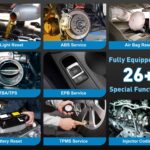The world of automotive diagnostics has evolved significantly over the years. If you’re working with older vehicles, you might be wondering about compatibility between modern OBD2 scanners and the older OBD1 systems. Specifically, can you directly plug an OBD2 scanner into an OBD1 port and expect it to work? Let’s delve into the intricacies of OBD1 and OBD2 to clarify this common question.
Understanding OBD1 and OBD2 Systems
To understand the compatibility issue, it’s crucial to first differentiate between OBD1 and OBD2.
What is OBD1?
OBD1, or On-Board Diagnostics generation 1, was the early generation of automotive diagnostic systems. Implemented in vehicles primarily before the mid-1990s, OBD1 systems were manufacturer-specific. This meant there was no standardization in terms of connector types, diagnostic protocols, or the trouble codes used. Each car manufacturer often had its own unique diagnostic system under the OBD1 umbrella. Accessing data from an OBD1 system often required specialized tools and manufacturer-specific knowledge.
What is OBD2?
OBD2, or On-Board Diagnostics generation 2, is the standardized system that became mandatory in the United States for all cars manufactured after 1996. OBD2 brought about significant improvements, including a standardized 16-pin Diagnostic Link Connector (DLC), a standardized set of diagnostic trouble codes (DTCs), and standardized communication protocols. This standardization made it much easier for mechanics and car owners to diagnose vehicle issues using generic OBD2 scanners, regardless of the car manufacturer. OBD2 provides more comprehensive diagnostic information compared to OBD1, covering emissions-related issues and various powertrain and sometimes chassis and body systems.
The Incompatibility Challenge
The core issue preventing direct OBD2 scanner use on OBD1 vehicles is the fundamental difference in their systems. OBD1 and OBD2 are not electronically or protocol compatible.
- Different Connectors: OBD1 systems used various connector types, often manufacturer-specific and not the standardized 16-pin DLC of OBD2.
- Different Communication Protocols: OBD1 systems employed proprietary communication protocols that varied between manufacturers. OBD2 utilizes standardized protocols like CAN, ISO, PWM, and VPW. An OBD2 scanner is designed to communicate using these standardized protocols, which are not present in OBD1 systems.
- Different Diagnostic Codes: While OBD2 standardized diagnostic trouble codes (DTCs), OBD1 codes were often manufacturer-specific and less detailed.
Due to these differences, directly plugging an OBD2 scanner into an OBD1 port will not work. The scanner will not be able to establish communication with the vehicle’s computer because it is not designed to understand the OBD1 system’s language or connector.
Can Adapters Bridge the Gap?
While direct connection is impossible, adapters are available that claim to bridge the gap between OBD1 and OBD2. These adapters are essentially pin converters. They physically adapt the OBD1 connector to fit the 16-pin OBD2 scanner plug.
Alt text: An OBD1 to OBD2 adapter cable, showing the different connector types and wiring.
However, it’s crucial to understand the limitations of these adapters. These adapters only change the physical connector; they do not translate the communication protocols. Therefore, simply using an adapter does not magically make an OBD2 scanner compatible with the OBD1 system at a communication level.
In many cases, using a basic OBD1 to OBD2 adapter with a standard OBD2 scanner will not allow you to read diagnostic codes or access vehicle data from an OBD1 system. The scanner still “expects” to communicate using OBD2 protocols, which the OBD1 system does not use.
Are There Any Solutions?
While using a standard OBD2 scanner with a simple adapter is generally ineffective, there are some specialized scanners and approaches:
- OBD1 Specific Scanners: The most reliable way to diagnose OBD1 vehicles is to use scanners specifically designed for OBD1 systems. These scanners are equipped to handle the various manufacturer-specific protocols and connectors of OBD1.
- Professional Scan Tools with OBD1 Adapters: Some professional-grade scan tools are designed to work with both OBD1 and OBD2. These tools often come with a set of OBD1 adapters and software capable of communicating with older systems. These are typically more expensive but offer comprehensive diagnostic capabilities for a wider range of vehicles.
- OBD2 Scanners with Limited OBD1 Support (Rare): Very few, if any, standard consumer-grade OBD2 scanners offer genuine OBD1 support. Be wary of scanners claiming OBD1 compatibility unless they explicitly state support for specific OBD1 protocols and come with appropriate adapters beyond just a pin converter.
Conclusion: Compatibility Requires More Than Just an Adapter
In conclusion, you cannot directly use a standard OBD2 scanner on an OBD1 vehicle due to fundamental differences in communication protocols and connector types. While OBD1 to OBD2 adapters exist, they are simply physical connector converters and do not bridge the communication gap. For effective diagnostics on OBD1 vehicles, it’s generally necessary to use OBD1-specific scanners or professional-grade scan tools equipped for both OBD1 and OBD2 systems. Understanding these distinctions is crucial for anyone working with both older and newer vehicles in automotive repair and diagnostics.
